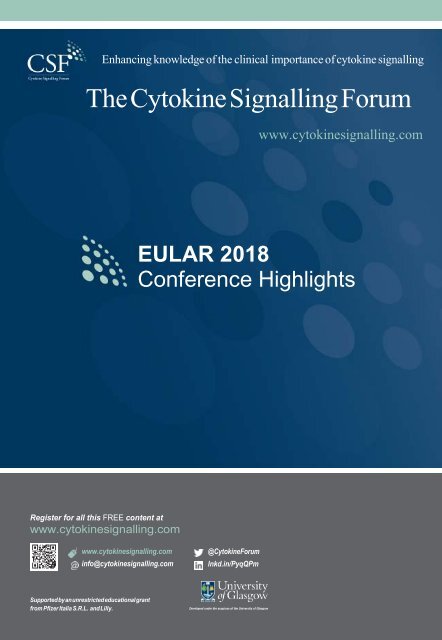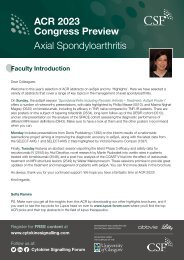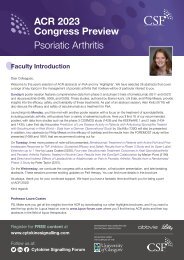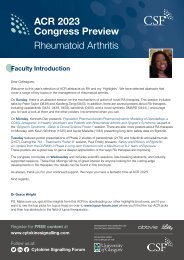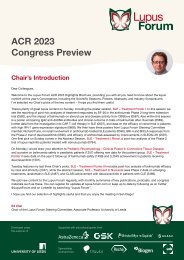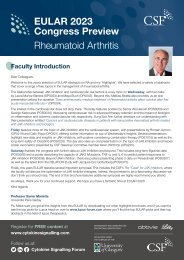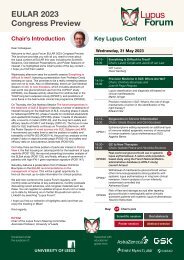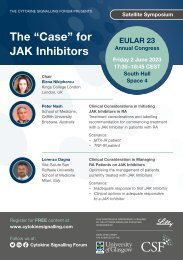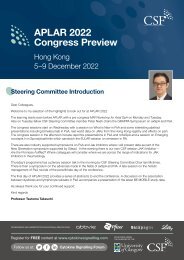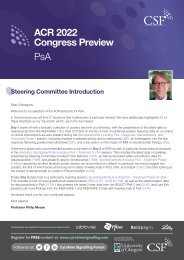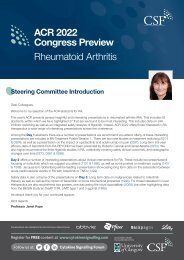EULAR 2018 Review
You also want an ePaper? Increase the reach of your titles
YUMPU automatically turns print PDFs into web optimized ePapers that Google loves.
Enhancing knowledge of the clinical importance of cytokine signalling<br />
The Cytokine Signalling Forum<br />
www.cytokinesignalling.com<br />
<strong>EULAR</strong> <strong>2018</strong><br />
Conference Highlights
<strong>EULAR</strong> <strong>2018</strong><br />
Conference Highlights<br />
Chairman’s Welcome<br />
Dear CSF Member,<br />
It is my pleasure to bring to you our review of the <strong>EULAR</strong> <strong>2018</strong> highlights, including a review of my ‘Chairman’s picks’.<br />
This year, there continues to be considerable data published on JAK inhibition, with differences in the JAK-STAT<br />
signalling pathway in synovial fibroblasts analysed in different joints [#OP0165], and the results of a systematic review<br />
and meta-analysis of Phase 2 and 3 JAK inhibitor studies presented for the risk of patients developing malignancies or<br />
serious infections [#OP0032].<br />
It was exciting to see the Phase 3 data for upadacitinib: Burmester et al shared the results from patients with an<br />
inadequate response to csDMARDs [#OP0036]; Genovese et al, presented the safety and efficacy of upadacitinib in<br />
bDMARD inadequate responders [#SAT0219]; and Smolen et al evaluated updacitinib as monotherapy [#OP0035]. We<br />
also saw the results of a Phase 2b/3 study of upadactinib in Japanese patients [#SAT0257].<br />
Tofacitinib continues to be prominent this year: data from the ORAL Strategy trial were presented, including the impact of<br />
glucocorticoids on tofacitinib efficacy and safety [#SAT0247], and the effect of live zoster vaccination [#SAT0220]; while<br />
Kaine et al presented data on tofacitinib discontinuation and re-initiation in long-term extension studies [#OP0037].<br />
Specific considerations included a comparison of the effectiveness of tofacitinib and bDMARDs in clinical practice<br />
[#AB0485], improvements in left ventricular mass and cardiac output [#AB0489]; and identification of subgroups, which<br />
could be used to develop personalised treatment algorithms [SAT0217].<br />
Baricitinib showed interesting and varied data, with post hoc analyses from Phase 3 trials examining the impact of<br />
controlling disease activity on physical function, and pain [#AB0258]. The effects of dose reduction were investigated<br />
[#SAT0253] and hepatitis B reactivation was examined [#FRI0077]; efficacy and safety of baricitinib were reported from<br />
the Phase 3 study RA-BALANCE, which enrolled patients in China, Argentina and Brazil [#SAT0218].<br />
Beyond RA, there were data in psoriatic arthritis (PsA); the effects of tofacitinib on several composite endpoint measures<br />
were presented from OPAL Broaden and Beyond [#THU0323]; and efficacy analysed by background methotrexate dose<br />
[#AB0902], and by baseline demographics, disease activity and concomitant medications [#AB0921]. The efficacy and<br />
safety of tofacitinib in patients with or without metabolic syndrome were also compared [SAT0317]. The safety,<br />
tolerability and efficacy of tofacitinib over 36 months were presented from the ongoing OPAL Balance study [SAT0293].<br />
Also of interest was an evaluation of the effect of tofacitinib on the ability of monocytes to differentiate into dendritic cells,<br />
an important step in innate immunity [#AB0046].<br />
The following pages provide a review of the highlights from <strong>EULAR</strong> <strong>2018</strong>. Once again, thank you for your support, and<br />
we hope you enjoyed your time at <strong>EULAR</strong>.<br />
Yours,<br />
Prof. Iain McInnes
Highlights from <strong>EULAR</strong> <strong>2018</strong><br />
During the <strong>EULAR</strong> <strong>2018</strong> annual meeting, many presentations and posters reported on<br />
cytokine signalling and related drugs. This document reviews the highlights.<br />
Oral presentations<br />
Abstract Session: RA therapy - new molecules and new strategies<br />
Upadacitinib Phase 3 results<br />
Phase 3 results for upadacitinib in 661 patients with RA and inadequate response (IR) to<br />
csDMARDs were reported in an oral presentation by Burmester, et al. At Week 12,<br />
significantly more patients receiving upadacitinib 15 mg and 30 mg QD versus placebo<br />
achieved an ACR20 response (63.8% and 66.2% vs 35.7%, P
interruption visit, AEs, SAEs and discontinuations due to AEs occurred in 54.4%, 11.1%<br />
and 1.5% of patients, respectively. The authors concluded that there was no loss of<br />
efficacy after temporary withdrawal of tofacitinib, and that the safety profile was consistent<br />
with that observed in previous LTE studies over 9 years [#0037].<br />
Malignancy and serious infection rates in clinical trials of JAK inhibitors for RA<br />
Lopez-Olivio, et al. presented a systematic review and meta-analysis of malignancies and<br />
serious infections during randomised controlled trials of JAK inhibitors in patients with RA.<br />
Thirty-one trials including 13 945 patients were included. Reported rates of malignancies<br />
across studies ranged from 0% to 2.0%, and rates of serious infections ranged from 0.7%<br />
to 5.4%. The most commonly reported malignancies were lung cancer, melanoma,<br />
nonmelanoma skin cancer (NMSC), basal cell and squamous cell carcinoma. Patients<br />
receiving the combination of JAK inhibitor plus MTX or JAK inhibitor monotherapy had<br />
numerically higher rates of malignancies, compared with MTX between 12 and 24 weeks<br />
before the rescue treatment was implemented (odds ratio [OR] 2.48, 95% confidence<br />
intervals [CI] 0.76–8.11 and OR 1.39, 95% CI 0.21–9.11, respectively). JAK inhibitor<br />
groups had similar rates of serious infections to those observed in the control groups.<br />
However, higher rates of serious infections were observed in patients receiving higher<br />
doses of JAK inhibitors [#0032].<br />
Abstract Session: Fires and firefighters: switching the immune system on and off<br />
Joint-specific differences in activation of the JAK-STAT pathway in RA<br />
Masterson and colleagues presented findings on substantial quantitative and qualitative<br />
differences in the JAK-STAT signalling pathway in synovial fluid (SF) from different joints.<br />
Using synovial fluid isolated from knee, shoulder and hand joints from patients with RA and<br />
osteoarthritis who were undergoing joint replacement surgery, the authors showed that the<br />
JAK-STAT pathway was enriched in knee SF versus hand and shoulder SF. Knee SF<br />
exhibited increased expression of JAK and STAT genes and enhanced signalling upon<br />
stimulation with IL-6/sIL-6R. The authors suggest that RA in different joints might not be<br />
equally sensitive to JAK-kinase inhibitors or blockade of IL-6, which has important<br />
implications for clinical practice and drug discovery in this therapy area [#0165].
Poster Sessions<br />
Poster Tour: Novel insights on non-biologics in RA<br />
Efficacy and safety of baricitinib at 52 weeks in the Phase 3 RA-BALANCE trial<br />
Li and colleagues presented 52-week efficacy and safety results from the Phase 3 RA-<br />
BALANCE trial. The study enrolled patients from China, Argentina and Brazil with<br />
moderately to severely active RA despite a stable background of MTX; patients received<br />
baricitinib 4 mg QD or PBO for 24 weeks, when patients receiving placebo were switched<br />
to receive baricitinib 4 mg QD until end of study. The primary endpoint, ACR20 at Week<br />
12, was significantly greater with baricitinib compared with placebo (58.6% versus 28.3%,<br />
P≤0.001). The ACR20 response observed at 12 weeks was maintained through 52 weeks<br />
in patients receiving baricitinib (Week 24: 64.1%; Week 52, 62.8%). Significant<br />
improvements in HAQ-DI physical function (PF), duration and severity of morning joint<br />
stiffness, and worst tiredness were observed at Week 12 with baricitinib versus placebo.<br />
Treatment-emergent adverse events (TEAEs) and serious infections during Weeks 0–24<br />
were reported in 74.5% and 42.1% of baricitinib patients (respectively) compared with<br />
62.1% and 28.3% of patients receiving placebo. No major adverse cardiovascular events<br />
(MACE), deaths, TB, venous thromboembolisms or malignancies were reported through<br />
Week 52 with baricitinib, and no unexpected safety signals were observed [#0218].<br />
Upadacitinib Phase 3 study results<br />
A poster by Genovese, et al. presented the results of a Phase 3, randomised, placebocontrolled<br />
trial of upadacitinib in patients with active RA and an inadequate response or<br />
intolerance to bDMARDs. In this study, patients received upadacitinib 15 mg or 30 mg QD,<br />
or placebo, followed by upadacitinib 15 mg or 30 mg QD starting at Week 12. Compared<br />
with placebo, more patients receiving upadacitinib achieved the primary endpoints of<br />
ACR20 and proportion achieving DAS28CRP≤3.2 (both at Week 12). Among patients with<br />
an inadequate response to multiple bDMARDs/MOAs, and those with lack of efficacy for<br />
alpha-IL-6, the proportions achieving ACR20 on upadacitinib versus placebo were<br />
comparable to the overall treated population. Overall rates of AEs were slightly higher for<br />
upadacitinib 30 mg QD versus upadacitinib 15 mg QD, and there were more serious<br />
infections and HZ cases in patients receiving upadacitinib 30 mg. PE was reported in two<br />
patients through Week 12, and four more patients through Week 24; all had risk factors for<br />
DVT/PE. One death in each upadacitinib dose group was reported. The overall safety<br />
profile was considered consistent with Phase 2 and other Phase 3 studies of upadacitinib<br />
[#0219].<br />
Tofacitinib and the effect of live zoster vaccine on herpes zoster events in RA<br />
Calabrese, et al. presented an evaluation of LZV in a subset of 1146 patients with RA<br />
treated with tofacitinib with or without MTX, and adalimumab plus MTX in ORAL Strategy.<br />
A total of 216 patients received vaccination with LZV. No patients had zoster-like lesions<br />
within 42 days of vaccination; one had vaccination-site erythema. In the overall study<br />
population, the incidence rate of HZ was similar between tofacitinib monotherapy and<br />
adalimumab plus MTX, and numerically higher with tofacitinib plus MTX. Overall, 18<br />
patients had HZ; only three vaccinated patients had HZ. No events were serious, and only
1 case was multidermatomal. Among the patients who were not vaccinated, 15 had HZ,<br />
there were 2 serious HZ events, 2 multidermatomal events and 1 disseminated event<br />
[#0220].<br />
Identification of heterogeneous phenotypic subgroups of patients with RA<br />
Bykerk and colleagues reported that it is possible to identify heterogeneous phenotypic<br />
subgroups with distinct disease activity in patients with RA who are csDMARD-IR and<br />
treated with tofacitinib. Models were based on pooled data from Phase 3 studies of<br />
tofacitinib 5 mg BID. The groups were characterised by differences in disease activity and<br />
patient-relevant outcomes, including baseline pain and physical function. The authors<br />
proposed that the identification of distinct disease trajectories could be used to develop<br />
personalised treatment algorithms incorporating clinical and molecular phenotypes<br />
[#0217].<br />
Poster Tour: Breakout news on non-TNF biologics in RA<br />
Real world evidence: bDMARD treatment persistence and reasons for discontinuation<br />
A poster on reasons for bDMARD cessation and subsequent persistence of second-line<br />
treatment in a large real world rheumatoid arthritis registry was presented by Youssef, et<br />
al. The analysis included patients aged ≥18 years with confirmed RA who were treated<br />
with first line b/tsDMARDs (1 st August 2010 to 30 th June 2017) by physicians participating<br />
in the OPAL-QUMI database. A total of 6914 patients received first line b/tsDMARDs.<br />
Treatment was stopped in 38% of patients; 34% stopped within 6 months of initiation, with<br />
the highest and lowest percentage observed in patients receiving tofacitinib (54%) and<br />
tocilizumab (17%), respectively. The most common reasons for stopping therapy within 6<br />
months were lack of efficacy (45%>abatacept, 44%>TNFis, 33%>tofacitinib and<br />
27%>tocilizumab) and adverse reactions (21%> tofacitinib, 20%> tocilizumab,<br />
15%>TNFis, 13%>abatacept). The percentage of patients remaining on 2nd line<br />
b/tsDMARD treatment after stopping first line TNFis due to lack of efficacy was the highest<br />
at 6 months with tocilizumab (78%) and at 12 months with rituximab (75%) [#0165].<br />
Poster Tour: The hydra beast in RA: a multifaceted disease<br />
Tofacitinib development programme: liver enzyme abnormalities<br />
Soriano, et al. reported a prevalence of hepatic steatosis of 1.6% in 10,212 patients across<br />
the tofacitinib RA, PsA and PsO programmes (1.3% in RA, 3.8% in PsA and 1.6% in PsO).<br />
In both tofacitinib- and placebo-treated patients, the incidence of elevated total bilirubin,<br />
aspartate aminotransferase (AST) and alanine aminotransferase (ALT) >1x ULN up to<br />
Month 3 was higher in patients with hepatic steatosis than in those without, across<br />
indications. The incidence of elevated total bilirubin, AST and ALT >3x ULN up to Month 3<br />
was low across indications, irrespective of hepatic steatosis [#0099].
Poster sessions I, II and III<br />
Upadacitinib efficacy and safety in RA<br />
FitzGerald, et al presented findings from the Phase 3 SELECT-NEXT (n=661) and<br />
SELECT-BEYOND (n=498) trials on the speed of response to upadacitinib across disease<br />
measures. In these cohorts of patients with RA and an inadequate response to csDMARDs<br />
or bDMARDs, those receiving upadacitinib at either 15 mg or 30 mg QD were more likely<br />
to achieve clinical responses at significantly earlier timepoints compared with patients<br />
receiving placebo. The median times to achieve ACR20 were 4 weeks with upadacitinib 15<br />
mg QD, 2–3 weeks with upadacitinib 30 mg QD, and 12 weeks with placebo. The median<br />
time to low disease activity (LDA) by CDAI and SDAI was approximately 12 weeks across<br />
upadacitinib doses and populations; patients receiving placebo did not achieve this<br />
measure within that time. The time taken to achieve various clinical responses was<br />
consistent irrespective of having an inadequate response to csDMARD or bDMARD<br />
[#0239].<br />
Vollenhoven, et al. examined upadacitinib efficacy at 12 weeks of treatment (as per T2T<br />
recommendations) in the SELECT-NEXT and SELECT-BEYOND trials. In both<br />
populations of patients with RA, significantly more patients on upadacitinib versus placebo<br />
achieved an ACR50 response. Among ACR50 responders at 12 weeks, approximately<br />
one-half of csDMARD-IR patients and one-third of the bDMARD-IR patients achieved an<br />
improvement in all 7 ACR components [#0244].<br />
Genovese, et al. presented the long-term safety and efficacy profile for upadacitinib from<br />
an ongoing open-label, long-term extension (OLE) of two Phase 2 studies (BALANCE-<br />
EXTEND). This included 493 patients with RA, with a total of 725 patient-years of<br />
cumulative exposure. The event rate per 100 patient years (E/100PY) was 170.5 for any<br />
AE in the OLE, 9.4 for SAEs, 2.3 for serious infection, 3.7 for HZ, 0.8 for malignancies<br />
excluding NMSC, and 0.7 for adjudicated cardiovascular events. There were 2 deaths (1<br />
sudden death adjudicated as unknown cause, and 1 due to Hodgkin’s lymphoma). Efficacy<br />
was maintained in patients receiving 6 mg upadacitinib BID from Day 1 of the OLE who<br />
completed Week 72 (55% of patients met ACR70, and 80% were in LDA by DAS28-CRP<br />
and CDAI) [#0236].<br />
The results of a Phase 3/4, randomised, placebo-controlled, double-blind study of<br />
upadacitinib in Japanese patients with active RA and an inadequate response to<br />
csDMARDs were presented in a poster by Tanaka, et al. A total of 197 patients received<br />
treatment and 187 completed the double-blind period. ACR20 rates at 12 weeks in patients<br />
receiving upadacitinib 7.5, 15, and 30 mg or placebo were 75.5%, 83.7%, 80% and 42.9%,<br />
respectively. ACR50 and ACR70 responses were achieved by significantly higher<br />
proportions of patients receiving upadacitinib versus placebo; more patients receiving<br />
upadacitinib 15 mg and 30 mg achieved these responses compared with those receiving<br />
upadacitinib 7.5 mg. The overall safety and tolerability profile was consistent with that<br />
observed in Phase 2 and 3 studies to date. Rates of any AEs, SAEs and infections were<br />
numerically higher in patients receiving upadacitinib 30 mg compared with the lower<br />
upadacitinib doses and placebo groups; CPK elevations and lymphopenia occurred more<br />
frequently with upadacitinib 30 mg [#0257].
Effect of upadacitinib on patient-reported outcomes in RA<br />
Strand, et al. presented two posters on patient-reported outcomes (PROs) with<br />
upadacitinib in the SELECT-NEXT and SELECT BEYOND studies. A total of 661 patients<br />
with active RA and an inadequate response to csDMARD were included in the analysis of<br />
PROs in SELECT-NEXT. Treatment with upadacitinib 15 mg or 30 mg daily for 12 weeks<br />
resulted in significant and clinically meaningful improvements in physical function, pain,<br />
fatigue, morning stiffness, QoL and work instability. Numbers Needed to Treat (NNT) with<br />
upadacitinib ranged from 4 to 8 patients [#0254]. A total of 498 patients with active RA and<br />
an inadequate response to bDMARDs were included in the analysis of SELECT-BEYOND.<br />
Compared with placebo at Week 12, upadacitinib-treated patients reported higher<br />
responses that were statistically significant and clinically meaningful for HAQ-DI, PtGA<br />
pain, pain, duration and severity of morning stiffness and SF-36 Physical Component<br />
Summary (PCS). NNT with upadacitinib ranged from four to eight patients in this difficultto-treat<br />
cohort [#0255].<br />
Tofacitinib efficacy and safety in RA<br />
Fleischmann and colleagues presented a post hoc analysis of the ORAL Strategy study<br />
describing the impact of background glucocorticoids on the safety and efficacy of tofacitinib<br />
(with and without MTX) and adalimumab with MTX. Patients with RA were randomised<br />
1:1:1 to receive tofacitinib 5 mg BID, tofacitinib 5 mg BID plus MTX, or SC adalimumab 40<br />
mg (every other week) plus MTX. In the cohort of 1146 patients who were randomised and<br />
treated, efficacy endpoints (ACR50 response rate, LDA, remission rates, change in HAQ-<br />
DI score) were generally similar for each treatment group when stratified by glucocorticoid<br />
use. Unexpectedly, glucocorticoid use did not appear to be associated with higher rates of<br />
AEs, discontinuations due to AEs, serious infection events, and SAEs [#0247].<br />
Cumulative probability plots showing clinical and functional efficacy across treatments for<br />
patients with RA in the ORAL Strategy study were presented by Takeuchi, et al. The<br />
proportion of patients who achieved responses of ACR20, ACR50 and ACR70 was similar<br />
for tofacitinib 5 mg BID plus MTX, and adalimumab SC 40 mg (every other week) plus<br />
MTX every other week but was numerically smaller for tofacitinib 5 mg BID monotherapy.<br />
Reductions from baseline in HAQ-DI were similar across treatment groups, although a<br />
slightly higher proportion of patients who received tofacitinib monotherapy reported an<br />
increase in HAQ-DI compared with other treatments. These data are consistent with the<br />
primary ORAL Strategy findings [#0252].<br />
Wiesenhutter examined the utility of various disease activity measures (DAMs) for clinical<br />
decision making during implementation of a treat-to-target (T2T) strategy, following the<br />
initiation of tofacitinib (n=39) and TNFis (n=40). Patients at a rheumatology clinic<br />
underwent disease activity measure (DAM) assessments, which included conventional<br />
clinical assessments, DAS28CRP, and the CDAI, as well as the ultrasound power Doppler<br />
joint count (UPDJC) and multi-biomarker disease activity score (MBDA). Patients<br />
underwent regular assessments, and if found to have inadequate control, changes were<br />
made in their clinical regimen and reassessment was performed 3 to 6 months later. All of<br />
the DAMs resulted in significant clinical responses with the exception that following the<br />
initiation of tofacitinib, the MBDA did not result in clinically significant improvement. When<br />
individual biomarkers from the MBDA were analysed, TNFi therapy led to significant<br />
reduction in 6 of 12 biomarkers (IL-6, TNF-R1, TNF-R2, MMP-2, SSA and CRP), whereas
treatment with tofacitinib lead to significant reduction of 2 (VCAM and resisten) and<br />
borderline reduction in 2 (IL-6 and TNF-R1), and a significant increase in one (leptin).<br />
[#0089].<br />
Effect of tofacitinib on patient-reported outcomes in RA<br />
Patient-reported outcomes (PROs) in the ORAL Strategy study were reported by Strand<br />
and colleagues. Patients with RA and an inadequate response to MTX were randomised<br />
1:1:1 to receive tofacitinib 5 mg BID, tofacitinib 5 mg BID plus MTX, or adalimumab 40 mg<br />
(SC, Q2W) plus MTX; PROs were assessed at 6 and 12 months, and included HAQ-DI,<br />
patient global assessment (PtGA) visual analog scale) VAS, pain VAS, SF-36 Health<br />
Survey, EuroQol (EQ)-5D VAS, Work Productivity and Activity Impairment (WPAI) and<br />
Functional Assessment of Chronic Illness Therapy-Fatigue (FACIT-F). Baseline and<br />
disease characteristics were similar among the 1146 treated patients. At 6 and 12 months,<br />
improvements in PROs were similar with tofacitinib plus MTX and adalimumab plus MTX,<br />
and were numerically greater than with tofacitinib monotherapy [#0256].<br />
Tofacitinib efficacy and safety in PsA<br />
Helliwell, et al. showed that tofacitinib improved composite measures of disease in 2<br />
Phase 3 studies of patients with PsA. Patients with active PsA and either an inadequate<br />
response to ≥1 csDMARD and who were TNFi-naïve (OPAL Broaden; N=422) or with an<br />
inadequate response to ≥1 TNFi (OPAL Beyond; N=394) were assessed for Psoriatic<br />
Arthritis Disease Activity Score (PASDAS), DAS28-3(CRP), disease activity score for<br />
reactive arthritis (DAREA)/ Disease Activity index for Psoriatic Arthritis (DAPSA) and<br />
CPDAI. In each study, both 5 mg BID and 10 mg BID doses of tofacitinib showed<br />
improvements in composite endpoints versus placebo at 3 months; the largest effect size<br />
and standardised response means were observed for PASDAS [#0323].<br />
A post hoc analysis of the OPAL Broaden and OPAL Beyond studies was presented by<br />
Ritchlin and colleagues; this analysis examined tofacitinib efficacy and safety in patients<br />
with PsA and comorbid metabolic syndrome (MetS) and included 294 patients with active<br />
PsA plus MetS, and 416 patients with active PsA and without MetS. Tofacitinib efficacy<br />
was generally similar in patients with and without MetS, as determined by ACR20<br />
response rate, change in HAQ-DI, Psoriasis Area and Severity Index (PASI)75 response<br />
rate, change in and PtGA VAS. In patients with MetS, AEs and SAEs occurred in 55.6%<br />
and 2.0% (respectively) of patients receiving tofacitinib 5 mg, and in 42.6% and 2.0% of<br />
those receiving tofacitinib 10 mg; corresponding rates in patients without MetS were 42.4%<br />
and 1.4% (5 mg) and 54.8% and 1.5% (10 mg). The authors concluded that tofacitinib<br />
showed a generally similar efficacy and safety profile in patients with PsA with or without<br />
MetS [#0317].<br />
Burmester, et al. reported minimal changes in absolute lymphocyte counts and lymphocyte<br />
subset counts in tofacitinib-treated patients with PsA, up to 6 months. An analysis of<br />
pooled data the Phase 3 OPAL Broaden and OPAL Beyond studies of tofacitinib in 816<br />
patients with PsA who had an inadequate response to ≥1 csDMARD or ≥1 TNFi found<br />
minimal decreases in total T cells (CD3+), cytotoxic T cells (CD8+) NK cells (CD16+56+)<br />
and a numerical increase in B cells (CD19+). Up to Month 12, serious infections were<br />
reported in seven tofacitinib-treated patients and one adalimumab-treated patient. There
was no suggestion of an increased risk of serious infection in any absolute lymphocyte<br />
count category [#0330].<br />
The third interim analysis of OPAL Balance, an open-label LTE study of tofacitinib in<br />
patients with PsA, was reported by Nash, et al. Of the 686 patients treated in the study,<br />
468 remained in the study at data cut-off. To 36 months, 2186 AEs were reported in 79.6%<br />
of patients. SAEs, discontinuations due to AEs and serious infections were reported in<br />
13.8%, 8.6% and 1.7% of patients, respectively.<br />
HZ was reported in 2.9% of patients, MACE in 0.7%, malignancies in 3.5% (including 12<br />
pts with NMSC) and uveitis in 0.3%. No AEs of GI perforation or inflammatory bowel<br />
disease were reported. There were 5 deaths, none of which were attributed to treatment as<br />
assessed by the investigator. The authors concluded that over 36 months in the LTE, the<br />
safety profile of tofacitinib in patients with active PsA was generally similar to that of the<br />
Phase 3 studies. Efficacy was maintained across multiple disease domains to Month 30<br />
[#0293].<br />
Effect of tofacitinib on patient-reported outcomes in RA, PsA and AS<br />
Ogdie, et al. showed that tofacitinib treatment (5 mg BID or 10 mg BID) was associated<br />
with a rapid and sustained reduction of pain in patients with RA, PsA and AS. In patients<br />
with RA or PsA who were csDMARD-IR or TNFi-IR, mean Patient's Assessment of Arthritis<br />
Pain (PAAP)-VAS at baseline (5 mg BID, range 55.7–65.7 mm; 10 mg BID, 54.4–60.1 mm)<br />
decreased as early as Week 2 and continued to decrease through Month 6 (30.9–34.4<br />
mm; 28.2–36.7 mm); decreases were numerically greater versus placebo and the<br />
magnitude of change was similar in RA and PsA populations. Improvements in SF-36v2<br />
and EQ-5D were observed in all four RA and PsA csDMARD-IR and TNFi-IR populations;<br />
there were improvements in Bath Ankylosing Spondylitis Disease Activity Index (BASDAI)<br />
in the csDMARD-IR PsA and TNFi-IR PsA populations. In the AS population,<br />
improvements from baseline in SF-36v2 Q7, SF-36v2 bodily pain (BP) domain, EQ-5D<br />
Pain/Discomfort (PD) domain and BASDAI Q2, were observed at Week 12 and were<br />
numerically greater than with placebo [#0221].<br />
No evidence for increased risk of DVT or PE with tofacitinib across disease states<br />
Mease and colleagues reported an analysis of DVT and PE across randomised clinical<br />
studies of tofacitinib in patients with RA, PsO, PsA and ulcerative colitis (UC). Up to Month<br />
3 in the placebo-controlled cohort, DVT and PE occurred in two patients receiving placebo<br />
(n=1 RA, n=1 UC); no tofacitinib-treated patients had DVT or PE events. In the dose<br />
comparison cohort, 2 DVT events occurred in tofacitinib-treated patients with RA (5 mg<br />
BID, n=1; 10 mg BID, n=1) and 1 DVT event in a patient with PsA (10 mg BID, n=1); 2<br />
DVT events occurred with MTX and none with adalimumab. With tofacitinib, 5 PE events<br />
occurred in the dose comparison cohort, all in patients with RA (5 mg BID, n=2; 10 mg<br />
BID, n=3). The authors concluded that there is no evidence for an increased risk of these<br />
events with tofacitinib versus other therapies [#0243].
Baricitinib dose step-down following sustained disease control<br />
The effects of baricitinib dose step-down in patients with RA who achieved sustained<br />
disease control with baricitinib 4 mg were presented by Takeuchi, et al. Patients who<br />
participated in the baricitinib Phase 3 LTE study and received baricitinib 4 mg for ≥15<br />
months, and achieved LDA or remission, were re-randomised to continue baricitinib 4 mg<br />
(n=374) or step-down to baricitinib 2 mg (n=376); patients could rescue to 4 mg. Most<br />
patients in both groups maintained LDA or remission over the 48 weeks; however, dose<br />
reduction to 2 mg resulted in significant increases in disease activity at 12, 24 and 48<br />
weeks, and a shorter time to relapse compared with the 4-mg group. Rates of SAEs and<br />
AEs leading to discontinuation were similar between groups; however, dose reduction was<br />
associated with a lower rate of serious infections. Most rescued patients were able to<br />
regain LDA or remission [#0253].<br />
Baricitinib: HBV reactivation and autoantibody profiling<br />
Harigai and colleagues presented the findings of a post hoc analysis examining hepatitis B<br />
virus (HBV) reactivation in patients with RA who participated in 4 Phase 3 trials of<br />
baricitinib. In a total of 2890 patients who received 1 or more dose of baricitinib (6993<br />
patient-years exposure), 269 patients had baseline serology suggestive of prior infection<br />
and post-baseline HBV DNA tests were performed in 290 patients. Approximately 12% of<br />
baricitinib-treated patients with prior HBV infection later tested positive for HBV DNA (3%<br />
were above the lower limit of detection); no patients developed clinical evidence of<br />
hepatitis, and antiviral therapy was not commonly required [#0077].<br />
An exploratory analysis of autoantibody profiles for response to baricitinib in patients with<br />
RA and no or limited exposure to MTX was presented by Martinez-Gamboa, et al. Baseline<br />
sera samples from patients participating in the Phase 3 trial RA-BEGIN were investigated<br />
for auto-antibody class reactivity towards vimentin (V), modified by citrullation (MCV),<br />
carbamylation (Carb) or acetylation. Seropositive patients with high titres of anti-MCV and<br />
anti-CarbV at baseline showed better responses to baricitinib monotherapy or baricitinib<br />
plus MTX for composite scores, and better response to baricitinib monotherapy in<br />
structural progression outcomes [#0109]<br />
Patient-reported outcomes with baricitinib<br />
Bingham and colleagues reported an analysis of PROs from the Phase 3 RA-BEAM and<br />
RA-BEACON trials of baricitinib in patients with RA with an inadequate response to MTX.<br />
FACIT-F and SF-36 BP scores were converted to Patient-Reported Outcomes<br />
Measurement Information System (PROMIS) Fatigue and Pain Interference (PI) scores, to<br />
permit comparisons with the general population. In both studies, baricitinib was associated<br />
with clinically relevant improvements through 24 weeks versus placebo for PROMIS<br />
fatigue and PI scores [#0106]. In a separate analysis, the authors converted HAQ-DI<br />
scores to PROMIS Physical Function (PF) scores. Treatment with baricitinib was<br />
associated with clinically relevant improvements in PROMIS PF versus placebo through 24<br />
weeks in both studies, and versus adalimumab through 52 weeks in RA-BEAM [#0013].
Real-world evidence: patterns of use with JAK inhibitors<br />
Chastek, et al. reported real-world patterns of use in biologic-naïve and biologicexperienced<br />
patients with RA who were newly prescribed a JAKi. In this retrospective<br />
analysis of 1059 patients (80.2% biologic-experienced), 72.4% of patients were not<br />
persistent for the 1-year following initiation of a JAKi, and 39.1% were not persistent<br />
beyond 90 days. For non-persistent patients, 42% interrupted JAKi treatment and<br />
restarted, 30% switched to a bDMARD and 28% discontinued. More biologic-naïve than<br />
biologic-experienced patients neither initiated a bDMARD nor restarted a JAKi after<br />
interruption (44.2% versus 23.3%, respectively; P
Publication only<br />
Efficacy and safety of tofacitinib for RA in clinical practice<br />
Aramaki, et al reported 52-week efficacy and safety with tofacitinib in patients with RA<br />
treated in routine clinical practice in Japan. In this cohort of 77 patients (n=23 biologicalnaïve)<br />
who all received tofacitinib 5 mg BID, the drug survival rate was 73.8% at 52 weeks;<br />
n=27 patients were treated for 104 weeks. Mean ESR-DAS decreased from 5.15 at<br />
baseline to 3.52 at 24 weeks, and 3.59 at 52 weeks. Mean CDAI decreased from 21.5 at<br />
baseline to 7.94 at 24 weeks, and 7.93 at 52 weeks. At 52 weeks, 16 patients (20.8%)<br />
achieved remission (DAS-ESR
for discontinuing tofacitinib were insufficient response (n=23), GI symptoms (n=18),<br />
infection (n=5), myalgia (n=2), remission (n=2), headache (2), cough, blue toe syndrome,<br />
intolerance, heart burn, psoriasis, and increased liver enzymes (all n=1). The authors<br />
concluded that tofacitinib is a safe and effective treatment option for patients with RA<br />
[#0497].<br />
Zengin and colleagues reported data from the Turkish TURKBIO registry on tofacitinib<br />
efficacy and safety in 180 patients with RA. Median duration of disease activity was 14<br />
years, and 75 patients had previously used ≥1 biologic agent. All disease activity<br />
parameters were significantly reduced versus baseline after 12 weeks of treatment, with<br />
6%, 59% and 27% of patients achieving remission, or with a moderate or high activity<br />
level, respectively. Most disease activity parameters were maintained until Week 60, the<br />
last examined time point. During the follow-up period, 9 AEs were observed [#0482].<br />
Drug survival rates with tofacitinib in RA: a single-centre cohort study<br />
Drug survival rates of tofacitinib in a single-centre cohort of 192 patients with RA with a<br />
median disease duration of 10 years were reported by Karakoc, et al. Approximately half of<br />
the cohort (48%) were biologic-naïve; tofacitinib was prescribed as monotherapy in 58% of<br />
patients and in combination with csDMARDs in 42% of patients. Drug survival rates were<br />
77% at 3 months, 69% at 6 months, 62% at 12 months, 54% at 18 months, 49% at 24<br />
months and 49% at 30 months. Discontinuation of tofacitinib treatment occurred in 27% of<br />
patients due to lack of response, and in 11% of patients due to side effects [#0502].<br />
Tofacitinib dose escalation and subsequent reduction in patients with RA<br />
Gaylis and colleagues reported data from a study of nine patients who were initially<br />
unresponsive to treatment with tofacitinib 5 mg BID and who were subsequently dose<br />
escalated to 10 mg BID to achieve LDA or remission. After 6 months of treatment with 10<br />
mg BID and a sustained LDA or remission, the patients were reduced back to 5 mg BID;<br />
six of nine patients were able to maintain LDA or remission over the following 6 months,<br />
and three patients were dose escalated back to 10 mg BID and achieved treatment target.<br />
These findings confirm that 10 mg BID of tofacitinib may be the effective dose required to<br />
reach treatment target for some patients with active RA and suggest that there is<br />
opportunity to reduce the escalated dose back down to the standard dose following<br />
achievement of a target response [#0282].<br />
Improvement of left ventricular mass and cardiac output with tofacitinib<br />
In a cohort study, Kume, et al. showed that tofacitinib monotherapy improved left<br />
ventricular mass and cardiac output in 24 patients with active RA (despite treatment with<br />
csDMARDs) and chronic heart failure. Tofacitinib significantly attenuated left ventricular<br />
mass as measured with cardio-MRI at baseline and 24 weeks; these effects were<br />
independent of tofacitinib’s effects on disease activity. The authors propose that the JAK-<br />
STAT pathway may be important for left ventricular hypertrophy, and that blockade of this<br />
pathway by tofacitinib may prevent cardiovascular morbidity and mortality in patients with<br />
RA and chronic heart failure [#0489].
A case study of vasculitis in a patient with RA treated with tofacitinib<br />
Muraviev, et al. presented a case of polyarteritis nodosa (vasculitis) in a female patient<br />
with RA. The patient was hospitalised in December 2016 due to painful eruption of<br />
indurated nodules on her legs, ulceration of nodules on her legs, painful hip and ankle<br />
joints and morning stiffness; the patient had been receiving tofacitinib 10 mg/day since<br />
November 2015, with rapid achievement of minimum RA activity. Tofacitinib was<br />
discontinued in June 2016 due to increasing lab activity of vasculitis. Histopathology<br />
showed the presence of cutaneous and subcutaneous fat and destructive vasculitis, and<br />
acute, predominantly lobular panniculitis, suggestive of polyarteritis nodosa and other<br />
systemic vasculitis. A causal relationship between this adverse drug reaction and<br />
tofacitinib therapy was assessed as probable (Naranjo scale) [#0413].<br />
Musculoskeletal ultrasound for monitoring the effects of biologic therapy in RA<br />
Yu and colleagues reported that musculoskeletal ultrasound (MSUS) was a useful tool for<br />
monitoring and following-up the effects of biologic therapy in patients with RA, for the<br />
assessment of inflammatory and destructive changes. In a real-world study of 18 patients<br />
with RA who were treated with tofacitinib 5 mg BID for 12 weeks, there was a significant<br />
correlation between MSUS scores and conventional (clinical and laboratory) measures of<br />
disease activity [#0210].<br />
Tofacitinib in patients with PsA: pooled sub-analyses of OPAL Broaden and OPAL Beyond<br />
Kivitz, et al. investigated pooled data from OPAL Broaden and OPAL Beyond, looking at<br />
the efficacy of tofacitinib by background MTX dose in patients with PsA. In total, data from<br />
556 patients who received tofacitinib plus MTX or placebo plus MTX were included in this<br />
analysis. Most patients were treated with background MTX at doses ≤15 mg/week (66.7%;<br />
mean dose 12.6 mg/week) compared with >15 mg/week (33.3%; mean dose 19.8<br />
mg/week). At Month 3, tofacitinib 5 and 10 mg BID were generally associated with<br />
numerically greater ACR and HAQ-DI response rates and greater changes from baseline<br />
in HAQ-DI score compared with placebo. The magnitude of tofacitinib effects on efficacy<br />
outcomes appeared broadly similar between background MTX dose groups [#0902].<br />
In a second pooled sub-analysis of the OPAL Broaden and OPAL Beyond studies,<br />
Behrens and colleagues examined the impact of baseline demographics, disease activity<br />
and concomitant medication on ACR20 response rate and HAQ-DI. Compared with<br />
placebo, tofacitinib 5 and 10 mg BID consistently improved efficacy at Month 3 across all<br />
predefined subgroups evaluated (race, ethnicity, gender, geographic region, PsA duration,<br />
age, BMI, PsA subtype, distal inter-phalangeal joint involvement, arthritis mutilans status,<br />
spondylitis status, baseline CRP, PASDAS, PASI score, DSS=0, concomitant csDMARD,<br />
corticosteroid use), with the exception of current smoking status [#0921].<br />
A novel mechanism of action for tofacitinib<br />
Marzaioli, et al. reported preclinical results suggesting a novel mechanism of action for<br />
tofacitinib. Pre-treatment of monocyte-derived dendritic cells (Mo-DC) from patients with<br />
RA and PsA inhibited Mo-DC differentiation. Furthermore, the decreased ability of
monocytes to differentiate into dendritic cells translated into a functional impairment of<br />
phagocytic ability. NOX5 protein expression was significantly decreased in pre-treated Mo-<br />
DC from PsA patients, and to a lesser extent in cells from RA patients. The authors<br />
proposed that inhibition of Mo-DC development by tofacitinib may alter migration of DC to<br />
the joint and subsequent activation of the immune response [#0046].<br />
Post hoc analyses of baricitinib Phase 3 studies<br />
Hepatic safety in patients with RA who received isoniazid (INH) for latent TB (LTBI) was<br />
reported by Hsieh et al. In this post hoc analysis of data from 3 Phase 3 baricitinib studies<br />
(n=2516 patients; RA-BEAM, RA BUILD, RA BEACON), 246 patients reported LTBI and<br />
169 had confirmed laboratory data and received INH as LTBI treatment. The percentage of<br />
patients with greater than one times the ULN levels of ALT was numerically higher in<br />
patients in the INH group versus no INH, and was consistent across placebo, baricitinib<br />
and adalimumab treatment groups. No treatment interruptions or discontinuations were<br />
reported in INH users in the baricitinib or adalimumab groups. The authors concluded that<br />
the data do not suggest an increased hepatic safety risk in patients receiving baricitinib<br />
and INH concomitantly [#0098].<br />
A post hoc analysis of the RA-BEAM and RA-BEGIN studies in patients with RA was<br />
reported by de Vlam, et al. The analysis showed that controlling disease activity by<br />
achieving LDA or remission increases the chance to regain normal physical function and<br />
relieve pain, independent of treatment (baricitinib monotherapy, baricitinib plus MTX or<br />
adalimumab). The data from RA-BEAM may indicate that achieving no/limited pain at<br />
Week 12 may be more likely with baricitinib compared with adalimumab, when achieving<br />
remission (83% versus 73%) [#0258].<br />
Pope and colleagues reported a post hoc analysis of RA-BEAM. The authors showed that<br />
reductions in pain and fatigue were associated with improvements in regular daily<br />
activities, presenteeism and work productivity, with patients who reported lower levels of<br />
fatigue and pain tending to experience greater improvements compared with patients with<br />
higher levels of pain and fatigue. When patients achieved a minimal level of pain (pain<br />
VAS ≤10 mm), similar improvements in presenteeism and work productivity were observed<br />
regardless of fatigue level. Similar results were observed between treatment groups<br />
[#0240].<br />
Phase 1 pharmacokinetic studies with upadacitinib in volunteers with renal impairment<br />
Mohamed, et al. reported results from a Phase 1 study that examined the<br />
pharmacokinetics of upadacitinib in 24 volunteers with either normal renal function or mild,<br />
moderate or severe renal impairment. In participants with mild, moderate and severe<br />
hepatic impairment, point estimates for plasma exposure ratios following a single 15 mg<br />
dose were 1.18, 1.33 and 1.44 for AUC and 1.06, 1.11 and 1.14 for maximum plasma<br />
concentration, relative to participants with normal renal function. The authors concluded<br />
that renal impairment has only limited effect upon upadacitinib pharmacokinetics, with<br />
mean plasma exposure in participants with severe renal impairment within 44% of that<br />
observed in patients with normal renal impairment [#0479].
In a separate dedicated Phase 1 study, Mohamed and colleagues examined the<br />
pharmacokinetics of upadacitinib in 18 volunteers with either normal renal function, or mild<br />
or moderate renal impairment. In participants with mild and moderate hepatic impairment,<br />
upadacitinib exposure ratio central values following a single 15 mg dose were 1.28, 1.24<br />
for AUC and 1.04, and 1.43 for maximum plasma concentration, relative to participants<br />
with normal renal function. The authors concluded that renal impairment has very limited<br />
effect upon upadacitinib pharmacokinetics (
References<br />
• Aramaki T, Kojima K, Kurushima S, Tsuji Y, Kawachi N, Iwamoto N, Ichinose K, Terada K, Eguchi K, Ueki Y,<br />
Kawakami A. Efficacy and safety of tofacitinib (TOF) in patients with rheumatoid arthritis at 52 weeks in clinical<br />
practice. Abstract 0500.<br />
• Behrens F, Gomez-Reino J, Nash P, Gladman DD, FitzGerald O, Ritchlin C, Kudlacz E, Wu J, Wang C, Romero<br />
AB. Impact of baseline demographics, disease activity and concomitant medication on American College of<br />
Rheumatology 20 response rate and Health Assessment Questionnaire-Disability Index score with tofacitinib in<br />
active psoriatic arthritis: a pooled subgroup analysis of 2 Phase 3 studies. Abstract 0921.<br />
• Bingham III CO, Gaich C, DeLozier AM, Quebe A, Sun L, Otawa S, Pope J. Converting patient-reported<br />
outcome measures of fatigue and pain to PROMIS scores: data from Phase 3 baricitinib rheumatoid arthritis<br />
trials. Abstract 0106.<br />
• Bingham III CO, Gaich C, DeLozier AM, Quebe A, Sun L, Otawa S, Pope J. Converting patient-reported<br />
physical function outcomes scores to PROMIS metric scores in Phase 3 trials of baricitinib in rheumatoid<br />
arthritis. Abstract 0013.<br />
• Burmester G, Kremer JM, van den Bosch F, Li Y, Zhou Y, Othman AA, Pangan AL, Camp HS. A Phase 3<br />
randomized, placebo-controlled, double-blind study of upadacitinib (ABT-494), a selective JAK-1 inhibitor, in<br />
patients with active rheumatoid arthritis with inadequate response to conventional synthetic DMARDS. Abstract<br />
0036.<br />
• Burmester G, Rigby WFC, Choy E, Nash P, Winthrop K, Mease PJ, Young P, Hendrikx T, Wang C, Menon S,<br />
Graham D. Changes in lymphocytes and lymphocyte subsets in tofacitinib-treated patients with psoriatic<br />
arthritis. Abstract 0330.<br />
• Bykerk VP, van Vollenhoven R, Connell C, Gruben D, Fallon L, Woolcott J, Keystone E. Identification of distinct<br />
disease activity trajectories in patients with rheumatoid arthritis receiving tofacitinib over 12 months. Abstract<br />
0217.<br />
• Calabrese LH, Abud-Mendoza C, Lindsey S, Lee S-H, Takiya L, Iikuni N, Soma K, Luo Z, Fleischmann R.<br />
Evaluation of live zoster vaccine in a subset of patients with rheumatoid arthritis treated with tofacitinib with or<br />
without methotrexate, and adalimumab with methotrexate: results from a Phase 3b/4 randomised trial. Abstract<br />
0220.<br />
• Chastek B, Koep E, Mallya UG, Cockerham A, Choi J, Boklage S, Furst DE. Real-world interruptions in janus<br />
kinase inhibitor therapy observed among biologic-naïve and biologic-experienced rheumatoid arthritis patients.<br />
Abstract 0177.<br />
• de Vlam K, Fautrel B, van de Laar M, Kirkham BW, Alten R, Van Beneden K, de Leonardis F, Lopez-Romero P,<br />
Gaich C, Quebe A, Cardoso A, Fleischmann R, Emery P. Impact of controlling disease activity on regaining<br />
normal physical function, and achieving no or limited pain in patients with rheumatoid arthritis treated with<br />
baricitinib. Abstract 0258.<br />
• Diller M, Hülser M-L, Hasseli R, Rehart S, Müller-Ladner U, Neumann E. JAK-inhibition with peficitinib and<br />
filgotinib in fibroblast-like synoviocytes in rheumatoid arthritis. Abstract 0492.<br />
• FitzGerald O, Rubbert-Roth A, Chen K, Meerwein S, Enejosa J, Shaw T, Wells AF. Rapid response with<br />
upadacitinib treatment in patients with rheumatoid arthritis and an inadequate response to csDMARDS or<br />
bDMARDS. Abstract 0239.<br />
• Fleischmann R, Wollenhaupt J, Cohen S, Smolen JS, Dahl P, Iikuni N, Shi H, Tatulych S, Takiya L. Impact of<br />
glucocorticoids on efficacy and safety of tofacitinib with and without methotrexate and adalimumab with<br />
methotrexate for rheumatoid arthritis: results from a Phase 3B/4 randomised trial. Abstract 0247.<br />
• Gaylis N, Sagliani J, Needell S. Adjusting the dose of tofacitinib to achieve optimal results in the management of<br />
patients with active rheumatoid arthritis (RA) may offer more successful results than utilizing a standard fixed<br />
one dose approach. Abstract 0282.<br />
• Genovese MC, Fleischmann R, Combe B, Hall S, Zhang Y, Zhou Y, Mohamed MF, Meerwein S, Pangan AL.<br />
Upadacitinib in patients with active rheumatoid arthritis and inadequate response or intolerance to biological<br />
dmards: a Phase 3 randomized, placebo-controlled, double-blind study of a selective JAK1 inhibitor. Abstract<br />
0219.<br />
• Genovese MC, Kremer J, Zhong S, Friedman A. Long-term safety and efficacy of upadacitinib (ABT-494), an<br />
oral JAK-1 inhibitor in patients with rheumatoid arthritis in an open label extension study. Abstract 0236.<br />
• Harigai M, Winthrop K, Takeuchi T, Hsieh T-Y, Chen Y-M, Smolen JS, Burmester GR, Walls C, Wu W-S,<br />
Dickson C, Liao R, Genovese MC. Hepatitis B virus reactivation in patients with rheumatoid arthritis treated with<br />
baricitinib: post-hoc analysis from clinical trials. Abstract 0077.
• Helliwell P, Coates LC, FitzGerald O, Nash P, Soriano ER, Husni ME, Hsu M-A, Kanik KS, Hendrikx T, Wu J,<br />
Kudlacz E. Tofacitinib improves composite endpoint measures of disease in patients with psoriatic arthritis.<br />
Abstract 0323.<br />
• Hsieh T-Y, Huang W-N, Tony H-P, Balsa A, Winthrop K, Harigai M, Dickson C, Wu W-S, de la Torre I, Liao R,<br />
Chen L, Kumar S, Combe B. Hepatic safety in patients with rheumatoid arthritis who received isoniazid for latent<br />
tuberculosis: post-hoc analysis from Phase 3 baricitinib studies. Abstract 0098.<br />
• Kaine J, Tesser J, DeMasi R, Takiya L, Wang L, Snyder M, Fan H, Bandi V, Wollenhaupt J. Efficacy of<br />
tofacitinib after temporary discontinuation in patients with rheumatoid arthritis: analysis of data from open-label<br />
long-term extension studies. Abstract 0037.<br />
• Karakoc Y, Ercan I. Drug survival analysis of tofacitinib in patients with rheumatoid arthritis. Abstract 0502.<br />
• Kivitz AJ, FitzGerald O, Nash P, Pang S, Azevedo VF, Kudlacz E, Wang C, Graham D, Takiya L. Efficacy of<br />
tofacitinib by background methotrexate dose in patients with psoriatic arthritis: a post-hoc analysis of pooled<br />
data from 2 Phase 3 trials. Abstract 0902.<br />
• Kragstrup TW, Mellemkjær A, Nielsen M, Heftdal L, Schafer P, Deleuran B. A MAPK activated kinase 2 inhibitor<br />
attenuates inflammatory and destructive arthritis in human ex vivo models. Abstract 0096.<br />
• Kume K, Amano K, Yamada S, Kanazawa T, Hatta K, Kuwaba N. Tofacitinib improves left ventricular mass and<br />
cardiac output in rheumatoid arthritis patients with chronic heart failure. Abstract 0489.<br />
• Li Z, Hu J, Bao C, Li X, Li X, Xu J, Spindler A, Zhang X, Xu J, Li Z, Wang G, Sun J, Ji F, Tao H, Zhan L, Rooney<br />
T, Zerbini C. Efficacy and safety of baricitinib in MTX-IR patients with rheumatoid arthritis: 52 week results from<br />
a Phase 3 study (RA-BALANCE). Abstract 0218.<br />
• Lopez-Olivo MA, Tayar JH, Zamora NV, Pratt G, Suarez-Almazor ME. Malignancies and serious infections in<br />
randomized controlled trials of janus kinase inhibitors in patients with rheumatoid arthritis: a systematic review<br />
and meta-analysis. Abstract 0032.<br />
• Luchikhina EL, Karateev D, Loukina G, Borisova M, Demidova N, Nasonov E. Comparative efficacy of tofacitinib<br />
and biologic dmards in patients with rheumatoid arthritis with insufficient response to subcutaneous<br />
methotrexate in clinical practice. Abstract 0485.<br />
• Martinez Gamboa LM, Bang H, Issa M, Zuckerman S, Cardoso A, Holzkaemper T, De Leonardis F, de la Torre<br />
I, Tanaka Y, Feist E. Autoantibody profiling for response to baricitinib in patients with rheumatoid arthritis and no<br />
or limited exposure to methotrexate. Abstract 0109.<br />
• Marzaioli V, Canavan M, Wade S, Low C, Veale DJ, Fearon U. Tofacitinib impairs monocyte-derived dendritic<br />
cell differentiation in rheumatoid arthritis and psoriatic arthritis. Abstract 0046.<br />
• Masterson T, Klein K, Karouzakis E, Distler O, Ospelt C, Bertoncelj MF. Joint-specific differences in the<br />
activation of the JAK-STAT pathway in rheumatoid arthritis. Abstract 0165.<br />
• Mease PJ, Kremer J, Cohen S, Curtis JR, Charles-Schoeman C, Loftus Jr EV, Greenberg J, Palmetto N, Kanik<br />
KS, Graham D, Wang C, Biswas P, Chan G, DeMasi R, Valdez H, Hendrikx T, Jones TV. Incidence of<br />
thromboembolic events in the tofacitinib rheumatoid arthritis, psoriasis, psoriatic arthritis and ulcerative colitis<br />
development programmes. Abstract 0243.<br />
• Mohamed M-EF, Coppola S, Feng T, Anderson J, Othman AA. Characterization of the effect of renal<br />
impairment on upadacitinib pharmacokinetics. Abstract 0479.<br />
• Mohamed M-EF, Coppola S, Feng T, Lacerda AP, Othman AA. Mild and moderate hepatic impairment have no<br />
clinically relevant impact on upadacitinib pharmacokinetics: results from a dedicated Phase 1 study. Abstract<br />
0478.<br />
• Mok CC, Wan R, Fong B. Prevalence and risk factors of serious infections in rheumatoid arthritis patients<br />
receiving the biologic/targeted synthetic DMARDS: a propensity score analysis from the Hong Kong biologics<br />
registry. Abstract 0425.<br />
• Mueller R, Popp F, Mattow F, Durmisi M, Souza A, Schulze-Koops H, Hasler P, von Kempis J. Effectiveness,<br />
tolerability, and safety of tofacitinib in rheumatoid arthritis: a retrospective analysis of real-world data from the<br />
St. Gallen and Aarau cohort. Abstract 0497.<br />
• Muraviev Y, Radenska-Lopovok S, Lebedeva V, Alamankina S. Nodular polyarteritis as an unforeseeable<br />
adverse reaction in RA patient treated with tofacitinib. Abstract 0413.<br />
• Nash P, Coates LC, Kivitz AJ, Mease PJ, Gladman DD, Covarrubias-Cobos JA, Fleishaker D, Wang C, Kudlacz<br />
E, Menon S, Fallon L, Hendrikx T, Kanik KS. Safety and efficacy of tofacitinib, an oral janus kinase inhibitor, up<br />
to 36 months in patients with active psoriatic arthritis: data from the third interim analysis of OPAL Balance, an<br />
open-label, long-term extension study. Abstract 0293.
• Ogdie A, de Vlam K, McInnes IB, Mease PJ, Baer P, Lukic T, Kwok K, Wang C, Hsu M-A, Maniccia A. Effect of<br />
tofacitinib on reducing pain in patients with rheumatoid arthritis, psoriatic arthritis and ankylosing spondylitis.<br />
Abstract 0221.<br />
• Pohlmeyer C, Cui Z-H, Han P, Clarke AS, Jones RM, Mollova N, Mikaelian I, Zaboli S, Shauf A, Di Paolo JA.<br />
Monotherapy with filgotinib, a JAK1-selective inhibitor, reduces disease severity and alters immune cell subsets<br />
in the NZB/W F1 murine model of Lupus. Abstract 0484.<br />
• Pope J, Michaud K, Emery P, Zhu B, Gaich C, DeLozier A, Zhang X, Dickson C, Smolen JS. Reduction in<br />
fatigue and pain are associated with improved work productivity in patients with RA. Abstract 0240.<br />
• Ritchlin C, Giles J, Ogdie A, Gomez-Reino J, Stockert L, Young P, Wang C, Romero AB, Kudlacz E. Tofacitinib<br />
in patients with psoriatic arthritis and metabolic syndrome: a post-hoc analysis of Phase 3 studies. Abstract<br />
0317.<br />
• Smolen JS, Cohen S, Emery P, Rigby W, Tanaka Y, Zhang Y, Friedman A, Othman AA, Camp HS, Pangan AL.<br />
Upadacitinib as monotherapy: a Phase 3 randomized controlled double-blind study in patients with active<br />
rheumatoid arthritis and inadequate response to methotrexate. Abstract 0035.<br />
• Soriano ER, Madariaga H, Castañeda O, Citera G, Schneeberger EE, Cardiel MH, Hendrikx T, Graham D, Shi<br />
H, Ponce de Leon D. Liver enzyme abnormalities after tofacitinib treatment in patients with hepatic steatosis<br />
from the rheumatoid arthritis, psoriatic arthritis and psoriasis clinical programmes. Abstract 0099.<br />
• Strand V, Mysler E, Moots RJ, Wallenstein G, DeMasi R, Gruben D, Soma K, Iikuni N, Fleischmann R.<br />
Tofacitinib with and without methotrexate versus adalimumab with methotrexate for the treatment of rheumatoid<br />
arthritis: patient-reported outcomes from a Phase 3B/4 randomised trial. Abstract 0256.<br />
• Strand V, Pope J, Tundia N, Friedman A, Camp HS, Pangan A, Ganguli A, Fuldeore M, Goldschmidt D, Schiff<br />
M. Upadacitinib improves patient-reported outcomes in patients with rheumatoid arthritis and inadequate<br />
response to conventional synthetic disease-modifying anti-rheumatic drugs: results from select-next. Abstract<br />
0254.<br />
• Strand V, Schiff M, Tundia N, Friedman A, Meerwein S, Pangan A, Ganguli A, Fuldeore M, Song Y, Pope J.<br />
Patient reported outcomes of upadacitinib: results from biologic inadequate responders (SELECT BEYOND<br />
Phase III trial). Abstract 0255.<br />
• Takeuchi T, Genovese MC, Haraoui B, Li Z, Xie L, Klar R, Correia AP, Otawa S, Lopez-Romero P, de La Torre<br />
I, Rooney T, Smolen JS. Dose reduction of baricitinib in patients with rheumatoid arthritis achieving sustained<br />
disease control: results of a prospective study. Abstract 0253.<br />
• Takeuchi T, Smolen JS, Fleischmann R, Iikuni N, Fan H, Soma K, Akylbekova E, Hirose T. Clinical and<br />
functional response to tofacitinib and adalimumab in patients with rheumatoid arthritis: probability plot analysis<br />
of results from the ORAL strategy trial. Abstract 0252.<br />
• Tamura N, Kuwana M, Atsumi T, Takei S, Harigai M, Fujii T, Matsuno H, Mimori T, Momohara S, Yamamoto K,<br />
Nomura K, Endo Y, Sugiyama N, Hirose T, Morishima Y, Yoshii N, Takagi M. Post-marketing surveillance of<br />
tofacitinib in Japanese patients with rheumatoid arthritis: an interim report of safety data. Abstract 0495.<br />
• Tanaka Y, Takeuchi T, Yamaoka K, Oribe M, Kawano M, Zhou Y, Othman AA, Pangan AL, Kitamura S,<br />
Matsuda N, Meerwein S, Kameda H. A Phase 2B/3 randomized, placebo-controlled, double-blind study of<br />
upadacitinib, a selective JAK1 inhibitor, in Japanese patients with active rheumatoid arthritis and inadequate<br />
response to conventional synthetic DMARDS. Abstract 0257.<br />
• van Vollenhoven R, Dore R, Chen K, Camp HS, Enejosa J, Shaw T, Suboticki JL, Hall S. Impact of 12 weeks of<br />
upadacitinib treatment on individual and composite disease measures in patients with rheumatoid arthritis and<br />
inadequate response to conventional synthetic or biologic DMARDS. Abstract 0244.<br />
• Vieira-Sousa E, Eusébio M, Ávila-Ribeiro P, Khmelinskii N, Machado AR, Rocha TM, Bernardes M, Santos-<br />
Faria D, Silva JL, Santos H, Miguel C, Carvalho P, Costa T, Teixeira L, Meirinhos T, Nero P, Santos MJ. Tumor<br />
necrosis factor inhibitors persistence in psoriatic arthritis patients. Abstract 0920.<br />
• Wiesenhutter C. Initiating tofacitinib in a treat to target strategy for rheumatoid arthritis leads to blunted multibiomarker<br />
disease activity scores as compared to anti-tumour necrosis factor agents. Abstract 0089.<br />
• Youssef P, Marcal B, Button P, Truman M, Bird P, Griffiths H, Roberts L, Tymms K, Littlejohn G. Reasons for<br />
bDMARD cessation and subsequent persistence of second line treatment in a large real world rheumatoid<br />
arthritis registry. Abstract 0165.<br />
• Yu CK-L. Clinical and musculoskeletal ultrasound assessment of therapeutic response to tofacitinib in patients<br />
with rheumatoid arthritis: real-world clinical experience from a single center in Hong Kong. Abstract 0210.<br />
• Zengin B, Inanç N, Akar S, Can G, Dalkilic E, Tufan A, Senel S, Koca SS, Capar S, Tugsal HY, Birlik M, Akkoc<br />
N, Onen F. Similar efficacy of tofacitinib on disease activity in rheumatoid arthritis patients with and without<br />
previous biologicals; results from the TURKBIO registry. Abstract 0482.
Enhancing knowledge of the clinical importance of cytokine signalling<br />
The Cytokine Signalling Forum<br />
www.cytokinesignalling.com<br />
<strong>EULAR</strong> <strong>2018</strong><br />
Conference Highlights


